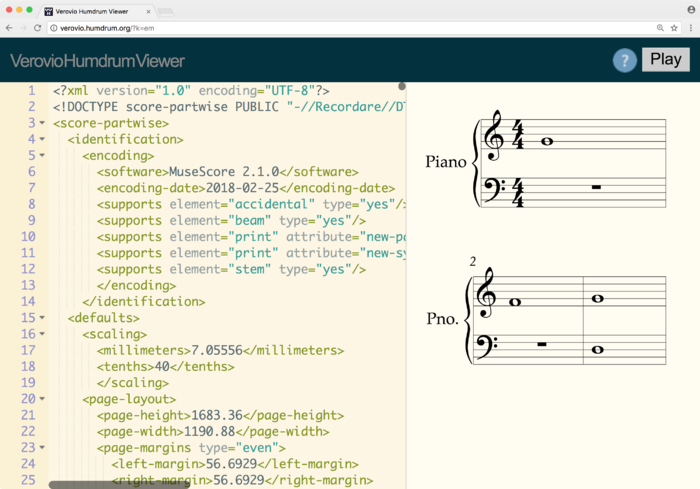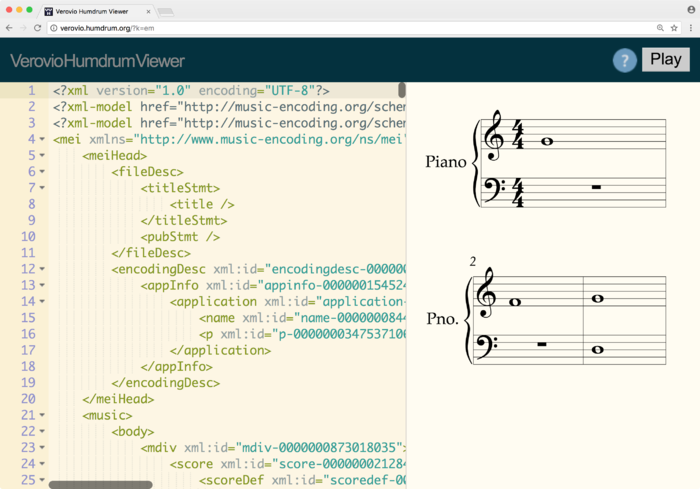Difference between revisions of "MusicXML and MEI homework"
| Line 49: | Line 49: | ||
=== Locations of features in MusicXML === | === Locations of features in MusicXML === | ||
| − | List and/or draw a tree diagram of the XML | + | List and/or draw a tree diagram of the XML path from the root node to each of the features that you created in your composition. |
For example, a note should have a path from the root node of the XML data like this: | For example, a note should have a path from the root node of the XML data like this: | ||
Revision as of 03:59, 27 February 2020
Contents
Compose a measure
Compose one measure of music in MuseScore, Finale, Noteflight, or Sibelius, etc. and export the score to a MusicXML file.
Your composition should have at least ten of the following musical features:
- a slur
- a tie
- a rest
- a chord
- a beam
- triplet rhythms
- a key signature
- some lyrics
- multiple verses of lyrics
- an accidental (sharp, flat, natural, double-sharp, double-flat).
- an implicit accidental (a note which should be played with an accidental, but it is not displayed in front of the note since it is in the key signature or a previous note at the same diatonic pitch in the measure).
- a dynamic marking (p, mp, mf, f, etc.)
- a crescendo/decrescendo hairpin/wedge
- an articulations (fermata, staccato, tenuto, accent, etc.)
- two or more layers/voices
- two or more staves (such as grand staff for piano, or two separate instruments)
- two or more measures
- instrument name before music
- transposing instrument
- a tempo marking (Allegro, Lento, Adagio, etc)
To save MusicXML data in MuseScore, go to the Menu "File→Export..." and then select the save type as "Uncompressed MusicXML file".
Copy/Paste into online editor
Open the MusicXML file in a text editor and copy the contents. This can be done on the command line in MacOS with the command:
cat file.musicxml | pbcopy
Then go to the webpage:
http://verovio.humdrum.org?k=e
and paste the MusicXML data into the text editor on the left side of the page, which should result in a view something like this after pasting:
Locations of features in MusicXML
List and/or draw a tree diagram of the XML path from the root node to each of the features that you created in your composition.
For example, a note should have a path from the root node of the XML data like this:
score-partwise/part/measure/note
Not all features will be explicitly encoded within a single containing element (chords for example), so describe in general how it is encoded if it is not obviously encoded. If a feature is encoded as an attribute use the following style, which shows where a measure number is stored in MusicXML:
score-partwise/part/measure@number
This means that measure numbers are stored in the "number" attribute of measure elements, which are contained within the part element which in turn is contained in the root element "score-partwise".
Locations of features in MEI
After recording the path to the features in MusicXML, Type alt-m on the same webpage. This should convert the MusicXML data into MEI data. For each of the features that you recorded the XML path in the MusicXML data, do the same for the MEI data.
Here is an example view of the MEI data after pressing alt-m:
What to hand in
Send Craig and Eleanor your MusicXML file, the converted MEI file and the path locations of your ten or more musical features in the MusicXML and MEI data (or an element map of the entire measure).

